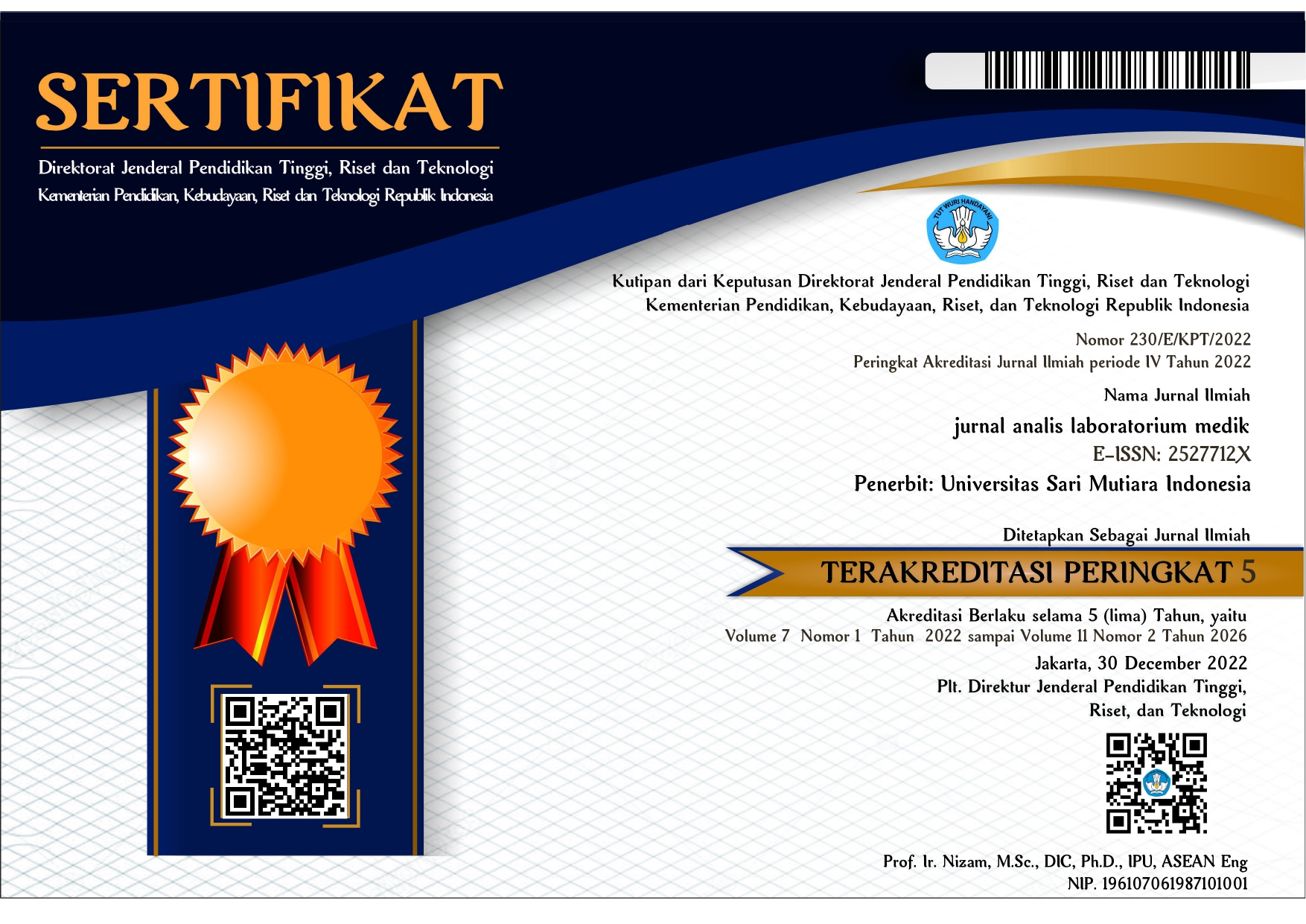Identification of Staphylococcus Aureus in Patients Diabetic Ulcus In Bunda Thamrin Hospital Medan
DOI:
https://doi.org/10.51544/jalm.v7i2.3376Keywords:
Staphylococcus aureus, Ulkus DiabetikumAbstract
Staphylococcus aureus can cause infection that usually presents with characteristic signs of inflammation, necrosis, and abscess formation. Staphylococcus aureus is responsible for 80% of suppurative diseases with the skin surface as its natural habitat. Skin infections and open wounds such as ulcers, burns, and surgical wounds increase the likelihood of bacterial infection and result in systemic infection. Identification of Staphylococcus aureus in diabetic ulcer patients was carried out at the Microbiology Laboratory of Bunda Thamrin Hospital Medan from February to March 2022 with a total sample of 6 people, this study is descriptive Experiment using isolation and identification methods. The results showed that of the 6 samples, 50% of the samples were contaminated with Staphylococcus aureus bacteria, 50% of the samples were contaminated with gram-negative rods. From the results of the study it can be concluded that Staphylococcus aureus is one of the bacteria that causes infection in diabetic ulcer patients. The results showed that of the 6 samples, 50% of the samples were contaminated with Staphylococcus aureus bacteria, 50% of the samples were contaminated with gram-negative rods. The results showed that of the 6 samples, 50% of the samples were contaminated with Staphylococcus aureus bacteria, 50% of the samples were contaminated with gram-negative rods. From the results of the study it can be concluded that Staphylococcus aureus is one of the bacteria that causes infection in diabetic ulcer patients.
Downloads
References
Agale, S.V. 2013. Chronic Leg Ulcers: Epidemiology, Aetiopathogenesis, and Management, Ulcers, pp. 1-9. http://dx.doi.org/10.1155/2013/413604. Diakses pada 4 febuari 2022.American Diabetes Association. 2014. Standards of Medical Care in Diabetes-2014. Diabetes Care, 37(1), pp. S14-S80.
Cappuccino, J.G dan N. Sherman. 2014. Manual Laboratorium Mikrobiologi. Jakarta: Buku Kedokteran ECG.
Damayanti, S. 2017. Diabetes Melitus & Penatalaksanaan Keperawatan. Yogyakarta: Nuha Medika.
Kartika, R.W. 2017. Pengelolaan Gangren Kaki Diabetik. Jakarta: Fakultas Kedokteran Universitas Kristen Krida Wacana. CDK-248:vol. 44 no.1.
Kementerian Kesehatan RI. 2019. Riset Kesehatan Dasar: Riskesdas 2019. Jakarta: Badan Penelitian dan Pengembangan Kesehatan Kemenkes RI.
Richard, J. L., Sotto, A. & Lavigne, J. 2011. New insights in diabetic foot infection. World J Diabetes, 2(2), pp. 24-32.
Sutanto, T. 2017. Diabetes Deteksi, Pencegahan, Pengobatan. Yogyakarta: Buku PintarSutanto, T. 2017. Diabetes Deteksi, Pencegahan, Pengobatan. Yogyakarta: Buku Pintar. Waworuntu, P. J., dkk 2016. Pola Bakteri Aerob Pada Pasien Ulkus Diabetikum Di RSUP Prof. Dr. R. D. Kandou Manado. Jurnal Kedokteran Klinik. 1(2) : 53-57. Universitas Sam Ratulangi.
Downloads
Published
How to Cite
Issue
Section
License
Copyright (c) 2022 Eka Margaret Sinaga, Mahyudi Mahyudi

This work is licensed under a Creative Commons Attribution-ShareAlike 4.0 International License.
Syarat yang harus dipenuhi oleh Penulis sebagai berikut:
Â
- Penulis menyimpan hak cipta dan memberikan jurnal hak penerbitan pertama naskah secara simultan dengan lisensi di bawah Creative Commons Attribution License yang mengizinkan orang lain untuk berbagi pekerjaan dengan sebuah pernyataan kepenulisan pekerjaan dan penerbitan awal di jurnal ini.
- Penulis bisa memasukkan ke dalam penyusunan kontraktual tambahan terpisah untuk distribusi non ekslusif versi kaya terbitan jurnal (contoh: mempostingnya ke repositori institusional atau menerbitkannya dalam sebuah buku), dengan pengakuan penerbitan awalnya di jurnal ini.
- Penulis diizinkan dan didorong untuk mem-posting karya mereka online (contoh: di repositori institusional atau di website mereka) sebelum dan selama proses penyerahan, karena dapat mengarahkan ke pertukaran produktif, seperti halnya sitiran yang lebih awal dan lebih hebat dari karya yang diterbitkan. (Lihat Efek Akses Terbuka).










